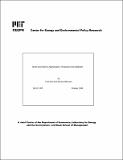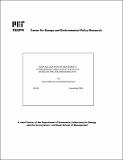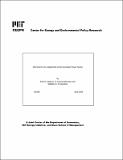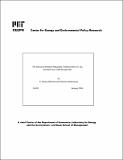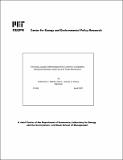Browsing Working Papers by Author "Ellerman, A. Denny"
Now showing items 21-30 of 30
-
New entrant and closure provisions : how do they distort?
Ellerman, A. Denny (MIT Center for Energy and Environmental Policy Research, 2006)As a person whose life began in England and ended in North America and who maintained academic affiliations in the United Kingdom, Canada and the U.S., Campbell Watkins had a fine appreciation for the subtle differences ... -
North Sea reserve appreciation, production, and depletion
Sem, Tone; Ellerman, A. Denny (MIT Center for Energy and Environmental Policy Research, 1999)Oil field "growth" has become a well-recognized phenomenon in mature, well-explored provinces such as the United States leading to the continual under-estimation in oil production forecasts. This working paper explores the ... -
Over-allocation or abatement? : a preliminary analysis of the EU ETS based on the 2005 emission data
Ellerman, A. Denny; Buchner, Barbara (MIT Center for Energy and Environmental Policy Research, 2006)This paper provides an initial analysis of the EU ETS based on the installation-level data for verified emissions and allowance allocations in the first trading year. Those data, released on May 15, 2006, and subsequent ... -
Short-term CO₂ abatement in the European power sector
Delarue, Erik D.; Ellerman, A. Denny; D'haeseleer, W. D. (MIT Center for Energy and Environmental Policy Research, 2008)This paper focuses on the possibilities for short term abatement in response to a CO2 price through fuel switching in the European power sector. The model E-Simulate is used to simulate the electricity generation in Europe ... -
The sources of emission reductions : evidence from U.S. SO₂ emissions from 1985-2002
Ellerman, A. Denny; Dubroeucq, Florence (MIT Center for Energy and Environmental Policy Research, 2004)An enduring issue in environmental regulation is whether to clean up existing "old" plants or in some manner to bring in new ₃clean₄ plants to replace the old. In this paper, a unit-level data base of emissions by nearly ... -
The temporal efficiency of SO₂ emissions trading
Ellerman, A. Denny; Montero, Juan-Pablo (MIT Center for Energy and Environmental Policy Research, 2002)This paper provides an empirical evaluation of the temporal efficiency of the U.S. Acid Rain Program, which implemented a nationwide market for trading and banking sulfur dioxide (SO2) emission allowances. We first develop ... -
Time and location differentiated NOX control in competitive electricity markets using cap-and-trade mechanisms
Martin, Katherine C.; Joskow, Paul L.; Ellerman, A. Denny (MIT Center for Energy and Environmental Policy Research, 2007)Due to variations in weather and atmospheric chemistry, the timing and location of nitrogen oxide (NOX) reductions determine their effectiveness in reducing ground-level ozone, which adversely impacts human health. Electric ... -
A Top-down and Bottom-up look at Emissions Abatement in Germany in response to the EU ETS
Feilhauer, Stephan M. (Stephan Marvin); Ellerman, A. Denny (2008)This paper uses top-down trend analysis and a bottom-up power sector model to define upper and lower boundaries on abatement in Germany in the first phase of the EU Emissions Trading Scheme (2005-2007). Long-term trend ... -
Why are allowance prices so low? : an analysis of the SO2 emissions trading program
Ellerman, A. Denny; Montero, Juan-Pablo (MIT Center for Energy and Environmental Policy Research, 1996)This paper presents an analysis of the reduction in SO2 emissions by electric utilities between 1985 and 1993. We find that emissions have been reduced for reasons largely unrelated to the emission reduction mandate ... -
The world price of coal
Ellerman, A. Denny (MIT Center for Energy and Environmental Policy Research, 1994)A significant increase in the seaborne trade for coal over the past twenty years has unified formerly separate coal markets into a world market in which prices move in tandem. Due to its large domestic market, the United ...

